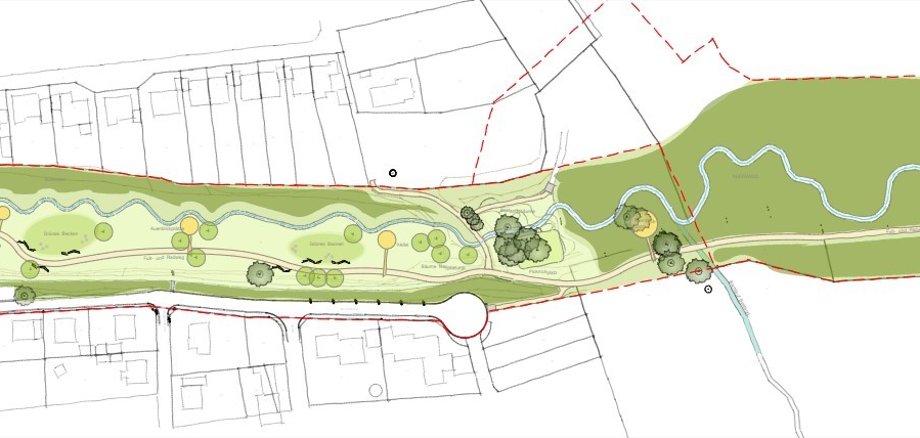Mayor organises
Ecological upgrading of the Hellbach
Watch the video here:
(Note: You will be redirected to Youtube)
More info:
Questions and answers:
Why does the city of Beckum want and need to tackle this project?
The redesign of the eastern Hellbachtal in Neubeckum is a flagship project from the integrated urban development concept (ISEK) for Neubeckum, which was developed in 2020. It states that the eastern Hellbachtal should be redesigned as a leisure and recreation centre for all age and user groups, taking into account aspects such as accessibility, climate protection and climate adaptation. On the basis of the ISEK, urban development funding can be acquired for this measure for a limited period of time - probably for the last time in 2026.
The wishes formulated in the ISEK Neubeckum for the renewal of the path over the dam and the desilting of the Hellbach pond are contrary to the objectives of water protection following a comprehensive basic investigation and analysis. In accordance with sections 6 and 27 of the Water Resources Act (WHG), the city of Beckum must restore the Hellbach, which is partially dammed, to a good ecological condition. The measures required to achieve this goal are described in the implementation roadmaps of the state of North Rhine-Westphalia and must be implemented by 2033.
The administration's interpretation is clearly confirmed in a letter from the district of Warendorf dated 13 February. It states: "The damming of the Hellbach and the so-called Hellbach pond, which can be perceived as a result, represents a massive migration barrier for upstream and downstream migration of aquatic life in the Hellbach watercourse. The damming of the Hellbach also prevents sediment transport. This disrupts the naturally interconnected habitat of a watercourse.
Is there an alternative, e.g. desilting the pond and installing a fish ladder?
In the course of the planning process, after extensive basic research and subsequent examination of the options, it was determined that complete preservation of the Hellbach pond in its current form is not possible for water law reasons.
At best, the Hellbach pond can be retained in a smaller form, as space is required to separate the course of the Hellbach from the pond. However, this option cannot be realised for reasons of funding, management or design.
The example mentioned here of installing a fish ladder and desilting and maintaining the existing impounded water surface cannot be realised either, as it does not meet the legal requirements. The impounded area as such would continue to represent an obstacle to river continuity, as aquatic organisms would not be able to pass through it.
This was clearly confirmed by the Warendorf district in its statement.
Does the measure have an impact on flood protection?
The impounded water area, which is perceived as a pond, does not currently fulfil any flood retention function.
Flood protection concerns are taken into account as part of the approval of this watercourse renaturalisation. A prohibition of deterioration applies. Accordingly, it must be ensured that the existing flood situation in this area does not change significantly. In principle, watercourse renaturalisation and floodplain development contribute to flood protection.
Does the measure threaten to dry out the Hellbach and cause a loss of biodiversity?
The dammed Hellbach is an artificially created habitat. The perceived "pond" is not a still body of water, but a dammed watercourse, in this case the Hellbach. This artificially created body of water is being replaced by the restoration of a natural watercourse in order to ensure ecological continuity for the aquatic life of the Hellbach and improve its ecological status. In the upper reaches of a watercourse, low water levels and even dry sections can occur naturally, but these do not lead to a loss of biodiversity in this habitat.
The perceived "pond" currently means that creatures from the stream can no longer orientate themselves in the dammed water surface and cannot move on due to the lack of current.
The current species population, adapted to this artificial habitat, will not remain the same in the future. However, the renaturalisation of the watercourse will create new habitats that will primarily promote the natural occurrence of species and increase biodiversity. Species protection issues will be examined as part of the planning process; in principle, the planned measure will lead to an ecological enhancement of the entire area.
Is the measure not too expensive in the current financial situation?
According to the current cost estimate, the administration assumes a total investment sum of 3.9 million euros (excluding a barrier-free north-south connection). Of this amount, 1.8 million euros will be spent on the watercourse reorganisation and 2.1 million euros on the urban upgrading. According to current estimates, 1.44 million euros can be acquired from the Flood Risk Management and Water Framework Directive funding programme and 1.26 million euros from urban development funding. This leaves the city's own contribution of around 1.2 million euros.
As clearly confirmed by the Warendorf district, the "pond" must be abandoned by 2033. However, it is unclear whether the Flood Risk Management and Water Framework Directive funding programme will be maintained until 2033. The possibility of acquiring urban development funding for urban upgrading at a later date is also unclear. It is currently possible to apply for urban development funding for the measure until 2026.
If the measure is implemented at a later date, the financial burden on the budget may therefore be significantly higher.

